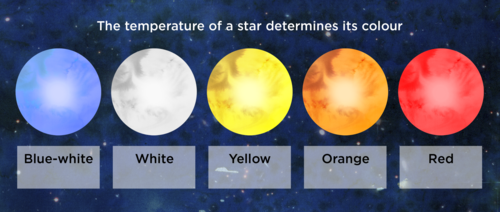November Topics, Evaluation Criteria and homework 1 15/10/18 - 19/10/18 3rd Grade, section II and III
3rd Grade, section II and III Astronomy Science
Stars, Galaxies
and the Universe
- · Stars
- · Describe how color indicates the temperatura of a star
- · Explain how a scientist can identify a star’s composition
- · Describe how scientist classify stars
- · Compare absolute magnitude with apparent magnitude
- · Identify how astronomers measure distances from Earth to stars
- · The Life Cycles of Stars
- · Describe different types of stars
- · Describe the quantities that are plotted in the H-R diagram
- · Explain how stars at different stages in their life cycle appear on the H-R diagram
Evaluation Criteria
1. Classwork 40%
2. Speaking Ability 20%
3. Homework: 20%
4. Quiz: 20%

Color
A star's color depends on its surface temperature. Cooler stars tend to be redder in color, while hotter stars have a bluer appearance. Stars in the mid ranges are white or yellow, such as our sun. Stars can also blend colors, such as red-orange stars or blue-white stars.
Brightness
Two characteristics define brightness: luminosity and magnitude. Luminosity is the amount of light that a star radiates. The size of the star and its surface temperature determine its luminosity. Apparent magnitude of a star is its perceived brightness, factoring in size and distance, while absolute magnitude is its true brightness irrespective of its distance from earth.


Comentarios
Publicar un comentario